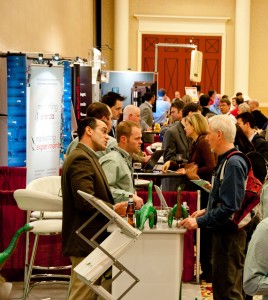Nine Simple Tactics to Drive a Higher Return on Trade Show Investment
Originally published on B2B LeadBlog
In his most recent post, Dave Green pointed out how marketers invest most of their budget on trade shows even though it ranks fourth in effectiveness. He went on to explain how to get a better return on your trade-show investment through lead scoring.
effectiveness. He went on to explain how to get a better return on your trade-show investment through lead scoring.
Now I’m going to share nine tactics that will drive those lead scores — and your ROI — even higher:
Do thorough research. Find out which attendees fit your Universal Lead Definition. If you have access to the registration list, analyze it. Look up registrants on LinkedIn. Develop a list of targets you want to seek out during the event. Research the sponsors, too. They should all be on the event website. There may be ways to join forces with them to reach your audience.
Leverage social media before, during and after the event. Connect with attendees and build your profile before the event through your blog and updates on Twitter and LinkedIn. Tweet relevant content during the event. Invite customer feedback afterward. There’s so much more than can be addressed in this post, so I advise looking online for more great ideas.
Creatively partner with event organizers. If you’re holding an educational or social event, brainstorm with them to see how they can help you attract more and better attendees. This could be everything from sending pre-event emails to including information in registration packages. Negotiate support before signing contracts to minimize costs and maximize opportunity.
Get involved with the event. Don’t just be a statue at a booth. Try to attend a few sessions, switch off with your team members to sit with attendees at lunch and engage on a personal level. It will help you build relationships and you will be able to strike up more relevant conversations if you just sat through the same keynote. Best of all, the conference will be more fun and you’ll learn a lot more.
Provide value, not trinkets. People attend events to gain knowledge and share it with their teams. Time is always tight as they try to take care of work back at the office while absorbing as much information as they can. That’s why you must always think about what’s in it for them to engage with your brand. Provide what they really can use: resources to drive their business to the next level — whether that’s a strategic piece of content, a tool or an opportunity to network with their peers.
Focus only on those who have expressed genuine interest. Trade shows often reward people if they visit as many booths as possible. At too many events, I’ve witnessed sales professionals requiring attendees to sit through a 10-minute presentation to “prove” they’ve visited the booth, when the attendees clearly don’t care about their product.
Are they interested? Take note. At minimum, jot your name and notes about their issues on their business card, and assign one person to collect and enter information into your database for follow up. Include the solution they’re interested in, the issue they’re trying to resolve, other contacts they’ve had with your organization, and any qualitative intel that will help the person following up — such as “launching a new website in Q2” or “unhappy with solution X.”
Promptly and professionally follow up. Before the event even begins, be ready to follow up. Prepare a brief, customizable email template to send out immediately afterward. It can come directly from the sales professional who spoke with the prospect, or it could reference the conversation and any key information you were able to capture. If the prospect doesn’t respond, follow up with a thoughtfully scripted phone call where you position yourself as a resource they can turn to when they are ready to talk. Don’t stalk and don’t be pushy, but do be responsive and close the loop. And be absolutely sure that only one person is doing the follow up. (This is why it’s critical to work from a single database.)
Track and measure the results. After the follow-up emails have been sent and calls have been made, note how many are still in your marketing and sales funnels, and how many deals closed. Monitor this throughout the year to determine whether the trade show is worth investing in the next time.
Do you have additional ideas on how to make the most of your tradeshow investments? I’d love to hear about them. Share them in the comments below.
Categories: Lead Generation B2B LeadBlog








